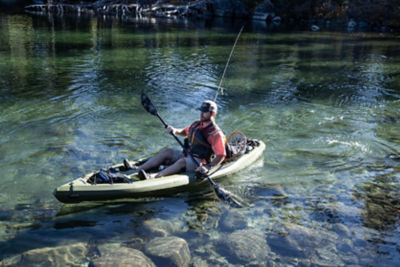How to Spool Your Spinning Reel
Filling your spinning reel the right way can help limit line twist and tangling troubles down the road. Start your fishing trip on the right foot with these line spooling Pro Tips.
Having a spinning reel at your disposal can be a huge asset on the water this fishing season. These popular fishing reels are easy to master and are great for lightweight lures and tackle. Despite these perks, however, any spinning reel can be rendered useless if the fishing line is not spooled properly from the start.
Understanding how to spool a spinning reel can help you avoid problems, such as line twist, loops and other hassles. Use these fishing Pro Tips to take the trouble out of your tackle on your next fishing adventure.
AN IMPORTANT STARTING NOTE
Unlike baitcasting reels, spinning reels are designed to work with lighter lines and lures. As a result, not every fishing line option will perform well under these limitations. Avid angler and DICK’S Sporting Goods Associate Candace Tabrosky recommends checking your reel prior to deciding on your line of choice.
“If you notice on the reel, there’s a line capacity on here,” she says.
This capacity outlines the specific line weight your reel can withstand, along with the line length, or how much fishing line your reel can hold. Be sure to match your line to your reel’s capacity.
EQUIPMENT LIST
Once you’ve looked at your spinning reel’s line capacity, you can begin to piece together your necessary gear for spooling a spinning reel. These items include:
- Fishing rod
- Spinning reel
- Monofilament fishing line
- Braided fishing line (optional)
Once everything is accounted for, you can begin the spooling process.
STEP-BY-STEP INSTRUCTION
“The first step you will want to do is lay down your pole and open your bail,” Tabrosky says on how to properly begin spooling your spinning reel.
Next, feed your monofilament line through the first eyelet of your rod. This is also a good time to make sure your fishing line is coming off its filler spool the same way it goes onto your spinning reel. For example, if your monofilament line comes off in a counterclockwise motion, it should go on in the same direction.
Matching these line actions can help lessen future line twists and other potential problems, so it’s best to take the necessary steps from the start.
Once you have your line through the first eyelet, Tabrosky says to tie one overhand knot at the end of your line. Next, go ahead and wrap your line around the spool and tie two more overhand knots. Pull on the main line until everything cinches down on the spool and then trim your tag end.
After you’ve secured your fishing line to the spool, close your bail and add some tension to the line by either pinching between your fingers or holding the line to the pole near the first eyelet. Make sure that your filler spool is lying flat with the label facing up and begin reeling.
“As I begin reeling, I’m going to make sure that the line is releasing nice and smooth off [the] packaging,” Tabrosky adds.
BONUS PRO TIP: If you notice your line beginning to twist, stop reeling, pull some line off your spinning reel, flip your filler spool and begin reeling again. This should help change the line’s direction and return it to normal.
Continue spooling your spinning reel until your line is one-eighth of an inch from the edge of the spool. At that point, you can cut your line and feed it through the remaining eyelets on your rod.
SPOOLING BRAIDED LINE
Braided fishing line can be a great choice for anglers needing a strong line in a thin profile. However, due to its slippery qualities and inability to grip the reel spool, a layer of backing is necessary for fishermen exploring this tackle option. A monofilament backing can help provide a better gripping surface for your braid while being a cost-effective choice, too.
First, attach your monofilament line to your spool and reel until you’ve filled it halfway. Next, thread your braided line through the first eyelet and attach it to your monofilament via double-uni knot. For more information on how to tie a double-uni knot, be sure to check out these fishing Pro Tips.
Once your braided and mono lines are connected, apply tension and continue spooling until you’re one-eighth of an inch from the spool’s lip. Trim your braided line, thread through the remaining eyelets and you’re officially ready to rig up for your next trophy catch.
Spooling a spinning reel is a simple task that, if done improperly, can significantly affect your gear’s performance. Cast out with confidence and use these fishing Pro Tips to help spool your reel the right way for a season’s worth of memories on the water.








